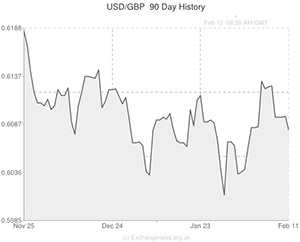
The Pound to US Dollar exchange rate (GBP/USD) completed a 0.6 cent rally from 1.6400 to 1.6460 yesterday afternoon in the wake of recently appointed Federal Reserve President Janet Yellen’s first testimony to the House.
Yellen emphasised the need for continuity in monetary policy, not just for the US economy but for the global financial system as a whole. Her speech indicated that she is willing to drop her dovish disposition in favour of a tighter approach to monetary policy.
She confirmed that the Fed will “likely reduce the pace of asset purchases in further measured steps at future meetings”, as long s labour market conditions continue to improve and CPI inflation continues to rise towards the 2.0% target.
With the last two Non-farm Payroll reports printing dismally, some traders had anticipated the arch-dove Yellen to highlight the potential pitfalls facing the US economy going forward. However, the new President chose not to focus on the NFP data, commenting only briefly that the “recovery in the labour market is far from complete”.
The speech made it clear that QE3’s days are numbered; this would usually be seen as a bullish indicator for the US Dollar. But not on this occasion.
GBP/USD’s 0.6 cent rally suggests that either: investors were concerned by some of her comments, or that markets opted to ‘buy the rumour and sell the news’ in order to accumulate some profit.
There is one thread of Yellen’s speech that could potentially have destabilised support for the ‘Greenback’. She mentioned that the number of people working part-time but that would like to be working full-time was “very high”. This statement could be an oblique reference to a different kind of index for measuring labour market performance.
The Bureau of Labour Statistics has six different Unemployment indexes ranging from U1 to U6.
U3 is the official Unemployment Rate used by the ILO and the majority of economic organisations; it measures the number of people who do not have jobs but have actively looked for work during the past four weeks.
U6 builds on the U3 headline rate; also incorporating “discouraged” workers (those who feel the economic climate means there is no work for them), “loosely attached workers” (those who would like work but have not looked recently) and part-time workers looking for full-time work.
Whilst U3 is currently running at 6.6% – just one percentage point higher than the Fed’s 6.5% target for considering raising interest rates – U6 is currently running at 12.7%.
If Yellen was making reference to the U6 Unemployment Rate in her speech, and if she intends to make use of a U6 threshold, it could give the Federal Reserve considerably more license to maintain ultra low interest rates and this would likely prove detrimental to the US Dollar.
However, this could well prove to be a tenuous link and it is notably more likely that GBP/USD’s rallies came as a result of classic ‘buy the rumour and sell the news’ profit-taking stances.
This refers to the possibility that traders bought the US Dollar ahead of the speech, in anticipation of a hawkish statement, and then sold the ‘Greenback’ when the news was released to make a small intraday profit.

Comments are closed.